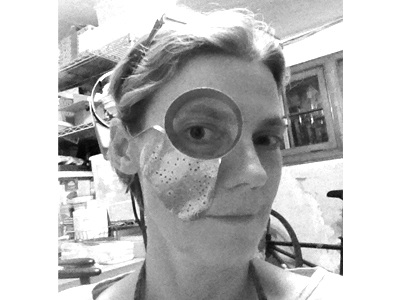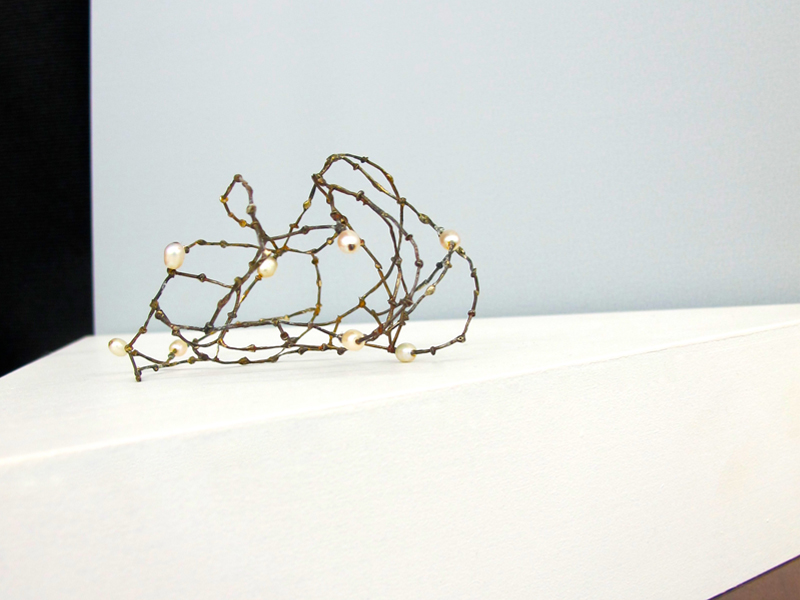
Nolia Shakti is a reflective artist who likes to challenge social stereotypes and the status quo. She comments on consumerism with her Throw Away Gold collection, made primarily out of Nespresso capsules, and on gender definitions with her Sexuality collection. She will participate—with a collective called Myths—in a mobile, group jewelry art exhibition called Test Drive (in a van!) at Munich Jewelry Week 2016 to pioneer conceptual jewelry to a wider audience.
Her current solo exhibition at the gallery Beyond Fashion in Antwerp, Belgium, is titled Male Made and continues her exploration of gender identity.
Adriana G. Radulescu: Why and how did you start making jewelry? Where did you study?
Nolia Shakti: In my late 30s, upon entering the conceptual jewelry department of Gerrit Rietveld Academie (GRA) in Amsterdam, my father said with natural ease: “… but of course, it makes sense, as a child you were always busy making things!”
I entered the academy late in my life, I was 32. I trusted that everything has its right timing. Prior to entering the art world, I spent 15 years working in London in investment banking and an office environment. Financial security and high status did not suppress my feelings of emptiness. I thought that there must be more to life, such as fulfilling your passion—my passion of making, creating, using my hands to transform my ideas into a touchable object.
Growing up in the Czech Republic, I was surrounded by craft, beadwork, embroidery, knitting, sewing. As a little girl I passionately spent hours making bead necklaces and embroidery. My dream was one day to visit the reputable and famous Jablonec bead factory, which I thankfully did as part of my research project during my GRA studies. It is an indescribable feeling sinking your hand into a huge barrel filled to the brim with small beads. Very sensual.
Where were you born, and where do you live now?
Nolia Shakti: I was born in Prague, Czech Republic, in 1971. Since 2002 I have lived and worked in Amsterdam.
What is the meaning of your exhibition title, Male Made?
Nolia Shakti: The collection Male Made is inspired by my interests in the representation of male and female; I see the male and female as two opposing subjects—despite their differences there is always a magnetic tension and a striving for unity.
I am continuing with the initial theme, Sexuality, which I have been working on since 2009, but in a more gentle and feminine way. Looking inward into a world of fragility and confusion, discomfort and beauty. I am curious to find out how we react to something fragile and beautiful, simultaneously giving us discomfort and irritation.
I am staying loyal to my three main materials: metal, pearls, and textile. Instead of using what for me are characteristically robust metal elements, I am selecting micro-size pieces, such as 8-mm steel nails, which I then shape or solder to create my structures.
The color scheme of my textile ranges from skin colored to old-fashioned pink cotton or silk. The strong desire to work with these colors streams from the search of the ultimate source of love … self-love.
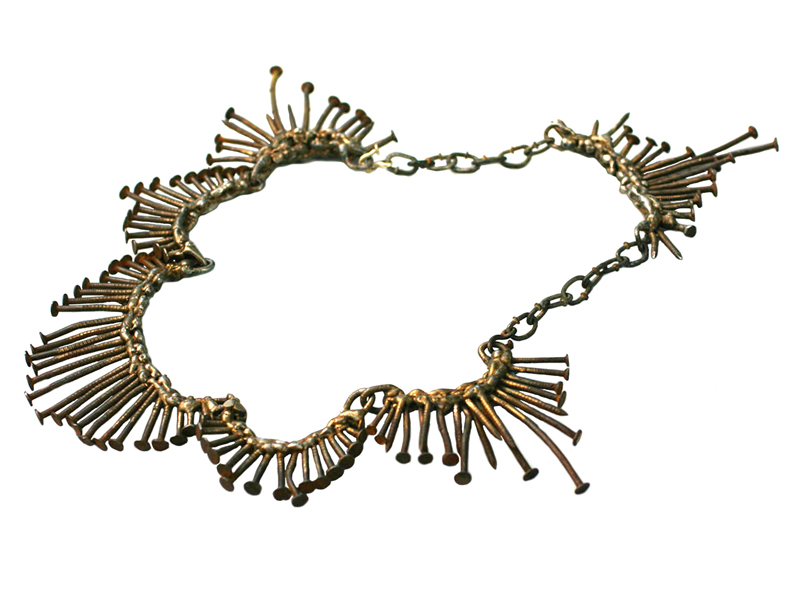
What inspires your work and what is your design process? I am curious in particular about the photographic archive from Nepal that is present on your website. Can you tell us how it influences your work?
Nolia Shakti: I am transfixed by the shapes and forms of everyday things, but mainly items which go unnoticed, such as a door handle, a rusty nail squeezed into asphalt, fruit opening, etc. These items remind me of male or female intimate forms. To me they are so sexual and provocative. Very often these items are micro size, I am literally zooming in.
In Nepal, during my six-week art residency, I made a photographic book of such items. My initial sighting was a thrown-away lady’s handbag lying open (like an open vagina) beside a busy street. I could not stop thinking how sad and representative it was of women’s story in Nepal. My book was called In Between. The order of photos was selected with mostly male shapes first, then progressing into male/female union, then gradually moving on to female shapes alone. I still take snapshots of such objects whenever I go and travel. My dream is to fill an exhibition space with this kind of photographic story (would love to realize it one day).
My design process: Very rarely I will draw or sketch prior to making (the recent exception is the necklace The Train Journey). Mostly I just start and let the process take me into the unknown.

In many of your pieces you use steel nails—traditionally associated with masculinity—in combination with “softer” materials: silver, gold, pearls—traditionally associated with femininity. You define their meeting point as “an individual new essence, which could be identified within the human world as the ambiguous group which we call ‘the intersex’ or a ‘third gender.’” Do you think that jewelry can be effective in pushing new forms of gender representation?
Nolia Shakti: Yes, I believe so. The jewelry I make is unisex; it is aimed at the male or female wearer or anyone who is not afraid to show their female/male side. The term “gender representation” to me is an unnatural word, created by a society that loves norms. Anyone who does not fit a norm is labeled “abnormal.”
Wearing my jewelry gives a strong liberating statement—such as a rough metal/pearls necklace; it confuses society. Which is good …
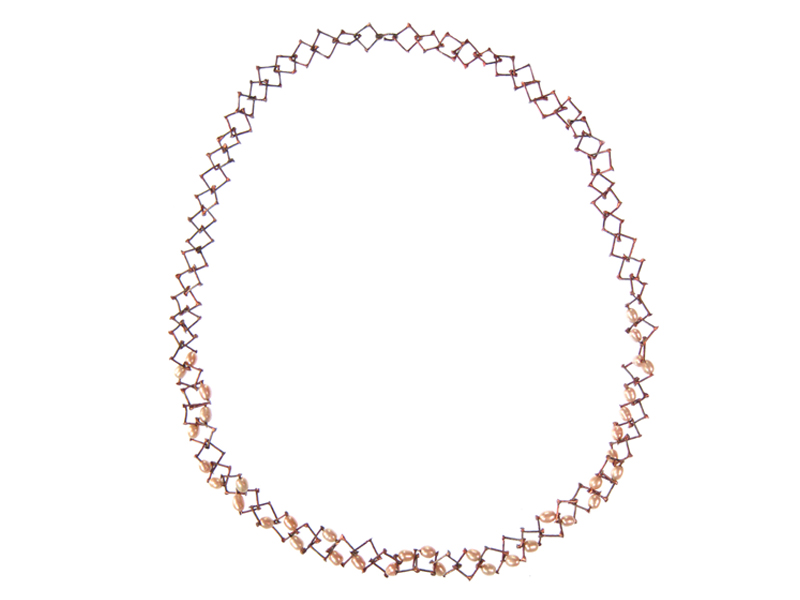
Some pieces have oxymoronic titles, such as Pink Nails. To what extent do you rely on the title to inform your work?
Nolia Shakti: During my dissertation work at GRA, titled Curious Path to (ab) Normal Sexuality, I discussed in detail how we arrived to normalization, in particular normalization in terms of gender. When did we start ostracizing anyone who does not fit the norm? In my collection Sexuality, I started using titles that are based on the gender paradox … Pink Boy, Two Spirited, etc. In my collection Male Made, I am following this trend.
What is the concept behind Object?
Nolia Shakti: The majority of necklaces in the Male Made collection follow a strict order, a repetition. When creating Object I had in mind an organic form, free and airy. My wish was to make the object much larger; despite many efforts, the material did not allow me to. So I have listened to it.
Object (which you can wear as a necklace) is a hand object that you nestle in your palm. It could be compared to a lady’s version of the steel male hand, brass knuckles.
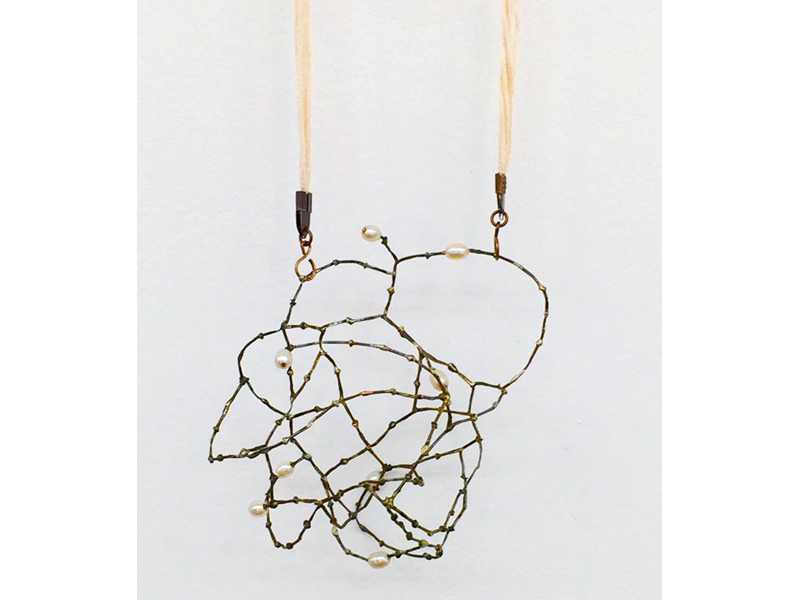
Your work in this exhibition seems to play in the same arena as Bruce Metcalf’s recent Nunc Stans series. Do you think that these works are part of a surge in interest in sexuality and gender in the field of jewelry?
Nolia Shakti: I believe that sexuality is a life energy that surrounds us: We see it, breathe it, speak it, move like it. Art jewelry, like any form of art, reflects the society and its development.
Can you tell us the story of the necklace piece titled Yes They Are … ?
Nolia Shakti: The necklace is made out of copper plumbing tubes, cut into small pieces and hammered into flat shapes. I damaged my shoulder by hammering so hard and for so long that I had to go to physiotherapy for one year. The pieces were lying in my drawer hidden for several years, I was afraid to touch them. A few months ago I just started working on it and finished the piece with much ease and satisfaction.
Each shape is individual, unique, and intricate in the same way as the female vagina opening. The title Yes They Are … is for the viewer to give an answer to what they might be guessing.

Your artist talk at the opening of the exhibition is titled Discomfort. Is it about physical or intellectual discomfort, or both? Do you think that discomfort is a good vehicle for change in people’s opinions? Don’t you think that your audience is by definition already complicit in your agenda?
Nolia Shakti: Discomfort is an absence of comfort or ease: mild pain, something that causes one to feel uncomfortable. I included the physical, beauty, and body discomfort in my talk. In our society we are accustomed to experiencing a slight to a larger discomfort every day, wearing tight bras, high heels, braces, body-shaping underwear … it is the price of achieving beauty perfection.
The antonyms to discomfort are comfort, luxury—that’s quite interesting, don’t you think, as we are dealing with art jewelry, which some regard as pure luxury.
In your work throughout the years you have been following diverse themes. What are you currently working on, what should we expect to see next?
Nolia Shakti: Indeed, the themes have been diverse, but my passion for material and pushing its limits remained the same. My next step is creating my own new material, a new hybrid … very exciting!
Thank you!
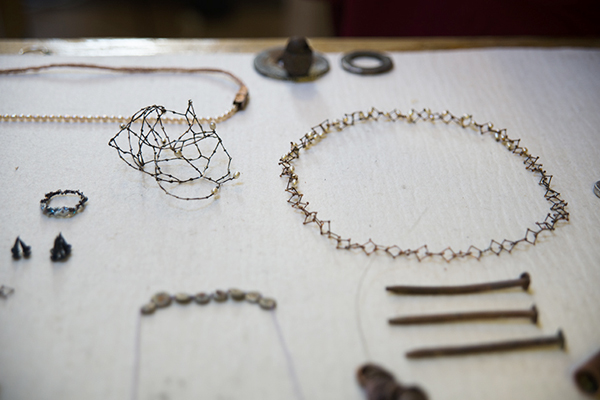
The works in this exhibition are priced between 160 and 2,600 euros (US$180 to $2,940).
